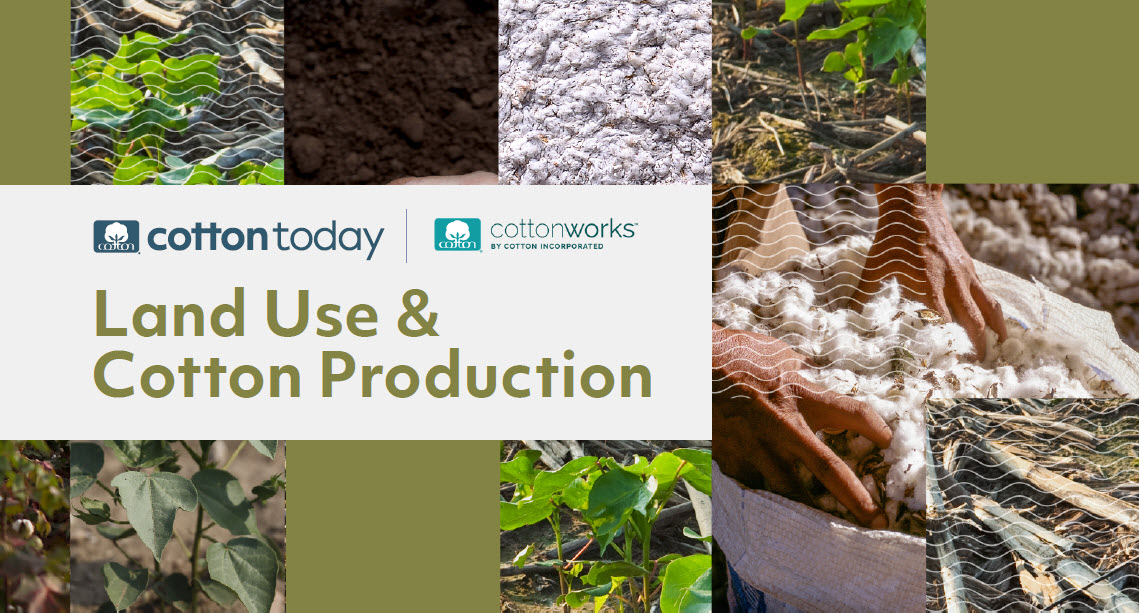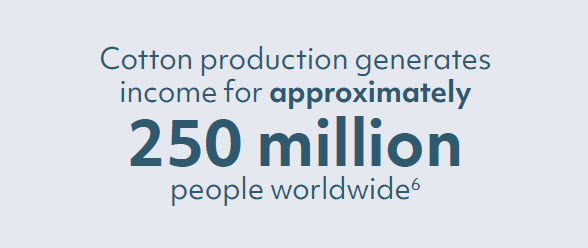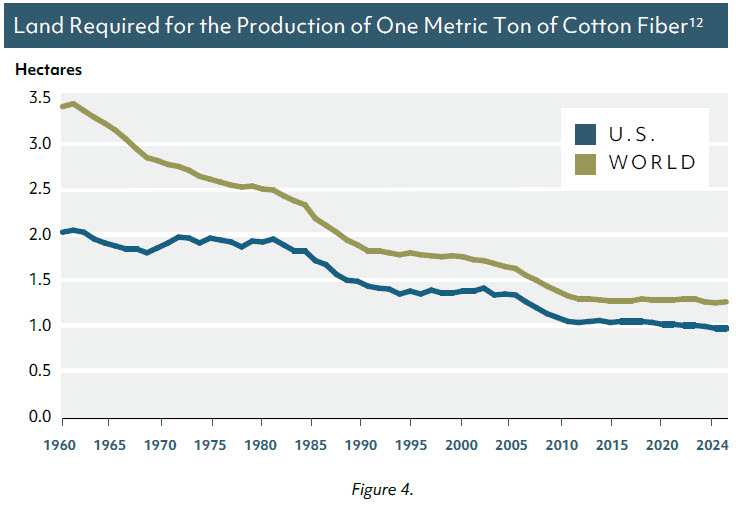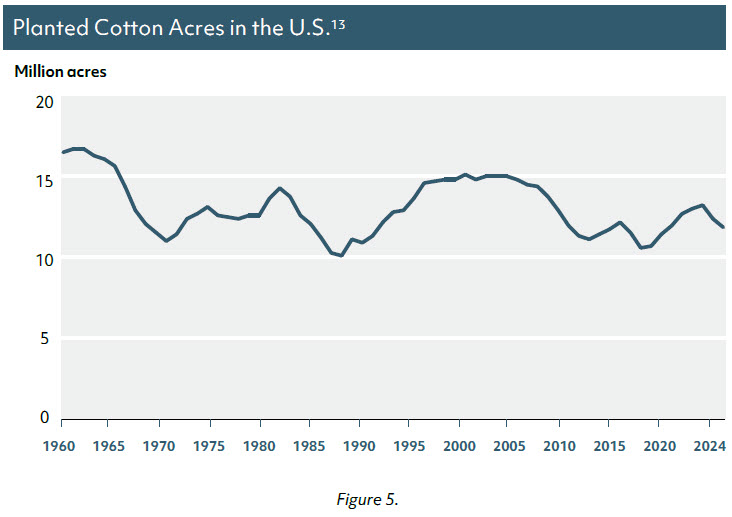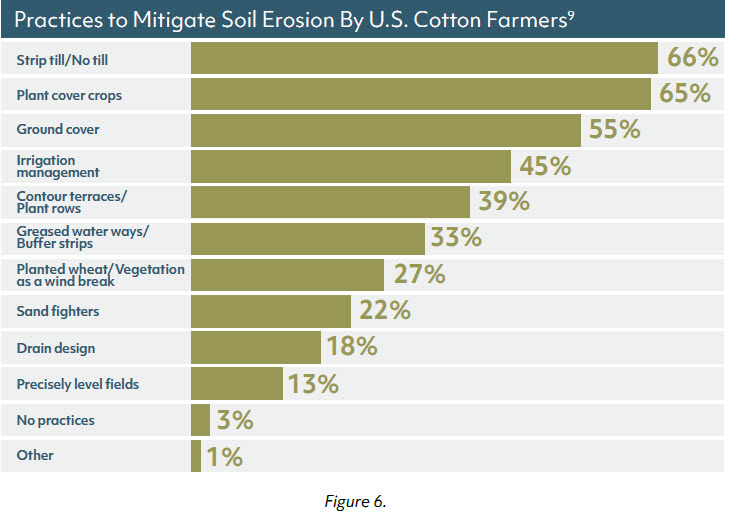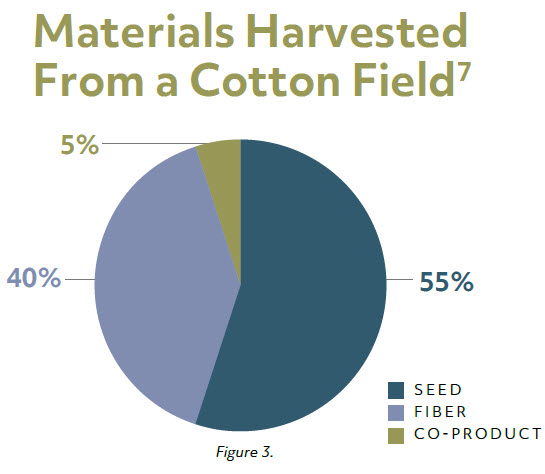By the middle of the century, there may not be enough arable land on earth to grow the amount of food and fiber needed to meet the demands of our surging global population. By 2050, the global population is expected to reach 9.6 billion.1 So, if we can’t produce more land, how can the world double and then triple its output of foods and fibers over the next 25 years?
How much land does it take to grow cotton?
Not a lot when considering all agriculture. Grown in 80 countries or more, cotton uses only 0.7% of the world’s agricultural lands, which include meadows and pastures commonly used for livestock grazing, and cropland 2. It is also important to remember that cotton produces both food and fiber to help meet these growing demands.
Not only does cotton use less land than many crops, it also produces two valuable products, fiber and seed. Cottonseed is a valuable feed for dairy cows and is also crushed to provide cottonseed oil for human consumption. Beyond the seed, other cotton co-products—such as gin
byproducts, stalks, hulls, and seed meal—can be used for animal feed, biofuels, bioplastics, biochemicals, and soil amendments, offering a range of practical applications across agriculture and industry.3,4 In 2022, cotton used 2% of the world’s cropland and represented 2.1% of global farm-gate value for crops.2 Nearly 24 million growers are directly involved in growing cotton globally.5
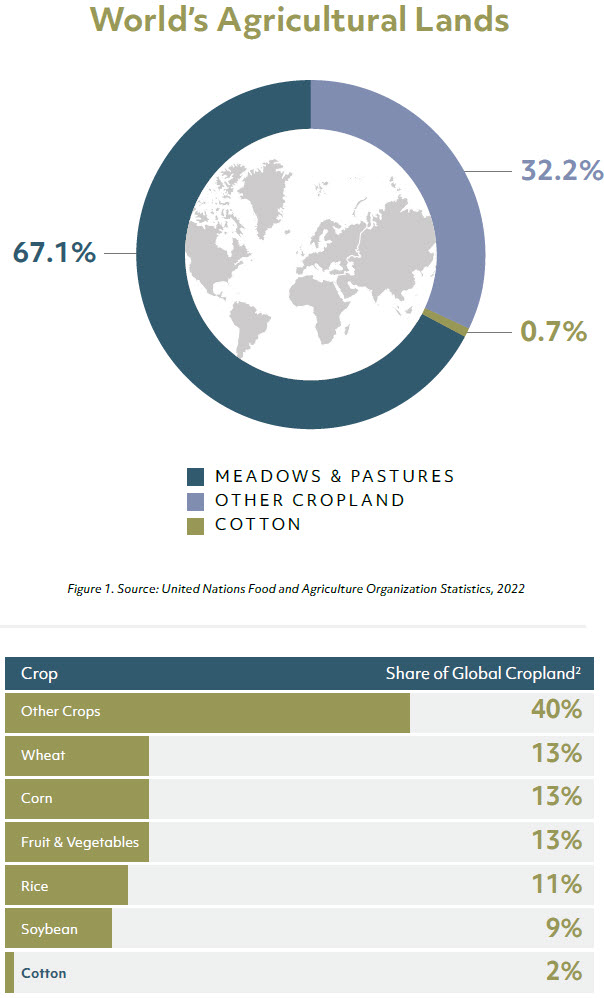
Is cotton more productive and land-efficient today than in the past?
Yes, thanks to scientific advancements in seed varieties 8 irrigation technologies, crop protection, and nutrient management, cotton production has become both more efficient and more productive.9 For instance, in 1980 it took over 1.9 hectares (4.7 acres) to produce one metric ton of cotton fiber in the U.S.. By 2024, only 1.02 hectares (2.5 acres) were required.10 Over the past four decades, U.S. cotton growers have increased their land use efficiency by 30% (see figure 4).11 Further, U.S. cotton planted acreage has remained relatively unchanged during this period, even as yields have continually increased (see figure 5). Globally, cotton lint yield has more than doubled since 1970, rising from 380 kg/ha to 862 kg/ha in 2024.10
How are cotton growers increasing their soil health?
To enhance soil health and reduce environmental impact, cotton growers worldwide are increasingly adopting conservation practices such as reduced tillage and winter cover cropping. These methods can improve soil structure, increase moisture retention, and reduce erosion. In Australia, more than 80% employ reduced tillage and nearly 50% incorporate cover crops.14 Increasing conservation adoption trends are also occurring in U.S. cotton production, where more than 60% of U.S. cotton growers use both no-till and cover crops (see figure 6) to reduce soil erosion9—underscoring the industry’s growing commitment to sustainability.
Are cotton farms a monoculture or is cotton grown in a rotation with other crops?
Cotton is commonly rotated with many other crops such as peanuts and soybeans.9 Rotating peanuts and soybeans can help fixate nitrogen in the ground, reducing fertilizer needs for cotton production. 15,16 In addition to rotational crops, many producers plant a cover crop (such as wheat or cereal rye) in the winter which protects the soil from erosion, increases soil moisture retention and soil organic content, that in turn may reduce crop fertilizer and irrigation water needs.9 Beyond that, cover crops can also control weeds and reduce insect pressure.17
1 World Bank Group (2025). DataBank Population estimates and projections. https://databank.worldbank.org/source/population-estimates-and-projections.
2 United Nations Food and Agricultural Organization. http://faostat.fao.org
3 Hamawand, I., Sandell, G., Pittaway, P., Chakrabarty, S., Yusaf, T., Chen, G., … & Hopf, J. (2016). Bioenergy from cotton industry wastes: a review and potential. Renewable and Sustainable Energy Reviews, 66, 435-448.
4 Cheng, H. N., Dowd, M. K., Selling, G. W., & Biswas, A. (2010). Synthesis of cellulose acetate from cotton byproducts. Carbohydrate polymers, 80(2), 449-452.
5 Karanthi, K. (2023). Cotton Production Data Portal. International Cotton Advisory Committee. https://icacdatabook.de.r.appspot.com/
6 Shanthi Radhakrishnan. (2017). Sustainable Cotton Production. Sustainable Fibres and Textile. https://doi.org/10.1016/B978-0-08-102041-8.00002-0
7 Faulkner, W. B., J. D. Wanjura, R. K. Boman, B. W. Shaw, C. B. Parnell, Jr. 2011. Evaluation of modern cotton harvest systems on irrigated cotton: harvester performance. Applied Engineering in Agriculture 27(4): 497‐506
8 ISAAA. 2018. Global Status of Commercialized Biotech/GM Crops in 2018: Biotech Crops Continue to Help Meet the Challenges of Increased Population and Climate Change. ISAAA Brief No. 54. ISAAA: Ithaca, NY.
9 Bayramova, J., Pires, S., Barnes, E., Morgan, G., Kurtz, R., and Daystar, J. (2024). “Sustainable cotton farming trends: Leveraging natural resource survey insights for U.S. cotton production,” BioResources, 19(4), 7279–7319.
10 United States Department of Agriculture (2024). Foreign Agricultural Service Production, Supply and Distribution Database. https://apps.fas.usda.gov/psdonline/app/index.html#/app/advQuery. Accessed 6/18/25.
11 Field to Market: The Alliance for Sustainable Agriculture, 2021. Environmental Outcomes from On-Farm Agricultural Production in the United States (Fourth Edition). ISBN: 978-0-578-33372-4
12 United States Department of Agriculture (2024). Foreign Agricultural Service Production, Supply and Distribution Database. https://apps.fas.usda.gov/psdonline/app/index.html#/app/advQuery.
13 United States Department of Agriculture NASS QuickStats. (2024). Cotton Planted Acres. https://quickstats.nass.usda.gov/
14 Australia Cotton Sustainability Update, 2023. Cotton Australia. https://cottonaustralia.com.au/assets/general/Documents/2023-Sustainability-Update.pdf
15 Smith, S. J., & Sharpley, A. N. (1990). Soil Nitrogen Mineralization in the Presence of Surface and Incorporated Crop Residues. Agronomy Journal, 2(1), 112–116. https://doi.org/10.2134/agronj1990.00021962008200010025x
16 Filová, A., Krivosudská, E., Ferencová, J. (2003). Soybean genotypic differences in sensitivity of symbiotic nitrogen fixation to soil dehydration. Scientific Journal for Phytotechnics and Zootechnics, 16(4), 78–82. https://doi.org/10.1007/BF00011896
17 Tillman, G., Schomberg, H., Phatak, S., Mullinix, B., Lachnicht, S., Timper, P., & Olson, D. (2004). Influence of cover crops on insect pests and predators in conservation tillage cotton. Journal of Economic Entomology, 97(4), 1217–1232. https://doi.org/10.1093/jee/97.4.1217
